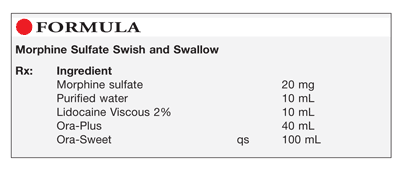US Pharm. 2013;38(10):42-43.

Method of Preparation: Calculate the quantity of each ingredient for the amount to be prepared. Accurately weigh or measure each ingredient. Dissolve the morphine sulfate in the purified water. Add the Lidocaine Viscous and mix well. Add 40 mL of Ora-Plus, followed by sufficient Ora-Sweet to final volume, and mix well. Package and label.
Use: This preparation has been used in the treatment of oral pain.
Packaging: Package in tight, light-resistant containers.
Labeling: Keep out of reach of children. Shake well before taking. Store in a refrigerator. Discard after ____ [time period].
Stability: A beyond-use date of up to 14 days when stored in a refrigerator may be used for this preparation.1
Quality Control: Quality-control assessment can include weight/volume, pH, specific gravity, active drug assay, color, rheologic properties/pourability, physical observation, and physical stability (discoloration, foreign materials, gas formation, mold growth).2
Discussion: This preparation has been used for relief of moderate-to-severe pain and discomfort in connection with irritated or inflamed mucous membranes of the mouth and pharynx resulting from various causes.
Morphine sulfate ([C17H19NO3]2.H2SO4.5H2O, MW 758.83) is a phenanthrene-derivative opiate agonist used in the treatment of severe, acute pain or moderate-to-severe chronic pain. It is odorless and occurs as white, feathery, silky crystals, cubical masses of crystals, or a white, crystalline powder. When exposed to air, morphine sulfate gradually loses water of hydration. It darkens on prolonged exposure to light. Morphine sulfate is soluble in water, freely soluble in hot water, and slightly soluble in alcohol. It is available as extended-release oral capsules and tablets, solution, tablets, suppositories, and injection.1
Purified water is water that is obtained by distillation, ion exchange, reverse osmosis, or some other suitable process. Water has a specific gravity of 0.9971 at room temperature, a melting point of 0°C, and a boiling point of 100°C. It is miscible with most polar solvents and is chemically stable in all physical states (ice, liquid, and steam).3
Xylocaine Viscous 2% (lidocaine hydrochloride) is a clear to almost clear, slightly colored, viscous liquid with an odor of cherries. It has a low surface tension, which provides for an even film over the mucous membrane. Prolonged contact is possible, owing to this agent’s high viscosity. Xylocaine Viscous 2% contains lidocaine hydrochloride 20 mg/mL, methylparaben, propylparaben, cherry essence, saccharin sodium, sodium carboxymethylcellulose to adjust viscosity, sodium hydroxide to adjust pH to 6.0 to 7.0, and purified water. It is packaged in 100-mL plastic bottles.
Lidocaine HCl (C14H22N2O.HCl.H2O, MW 288.81) occurs as a white, odorless, crystalline powder with a slightly bitter taste. It is an amide-type local anesthetic with a rapid onset and an intermediate duration of action. Lidocaine HCl is highly soluble in water (1:0.7) and in alcohol (1:1.5). A 0.5% aqueous solution has a pH in the range of 4.0 to 5.5, and the injection has a pH ranging from 5.0 to 7.0. Lidocaine HCl should be protected from light, and its melting point is in the range of 74°C to 79°C. It is available in both anhydrous and monohydrate forms. Approximately 1.16 g of lidocaine HCl is equivalent to 1 g of lidocaine. Lidocaine HCl is reported to be incompatible in solution with amphotericin, sulfadiazine sodium, methohexitone sodium, cefazolin, and phenytoin sodium. In polyvinyl chloride IV solution bags, the agent has been reported to exhibit pH-dependent sorption of the plastic.1,4
Ora-Plus is an oral suspending vehicle that accepts dilution of up to 50% or more with water, flavoring agents, or syrups and still retains its suspending properties. It has a pH of approximately 4.2 and an osmolality of about 230 mOsm/kg. Ora-Plus is a thixotropic vehicle with a viscosity of approximately 1,000 cps at 25°C. It contains purified water, microcrystalline cellulose, sodium carboxymethylcellulose, xanthan gum, carrageenan, sodium phosphate, and citric acid as buffering agents, simethicone as an antifoaming agent, and potassium sorbate and methylparaben as preservatives.5
Ora-Sweet syrup vehicle is a flavoring vehicle for oral extemporaneous preparations. It is flavored with a citrus-berry flavor blend and contains glycerin and sorbitol to prevent “cap lock,” a problem associated with many syrups. Ora-Sweet is buffered to a pH of approximately 4.2 and has an osmolality of about 3,240 mOsm/kg. It contains purified water, sucrose, glycerin, sorbitol (5%), flavoring, sodium phosphate, and citric acid as buffering agents, and potassium sorbate and methylparaben as preservatives.6
REFERENCES
1. U.S. Pharmacopeia 36/National Formulary 31. Rockville, MD: U.S. Pharmacopeial Convention, Inc; 2013:355-398,1268,1273.
2. Allen LV Jr. Standard operating procedure for performing physical quality assessment of oral and topical liquids. IJPC. 1999;3:146-147.
3. Dubash D, Shah U. Water. In: Rowe RC, Sheskey PJ, Cook WG, Fenton ME, eds. Handbook of Pharmaceutical Excipients. 7th ed. Washington, DC: American Pharmaceutical Association; 2012:880-884.
4. Lidocaine hydrochloride. In: Allen LV Jr, ed. Remington: The Science and Practice of Pharmacy. 22nd ed. Philadelphia, PA: Pharmaceutical Press; 2012:1557.
5. Ora-Plus product information. Minneapolis, MN: Paddock Laboratories, Inc; 2010.
6. Ora-Sweet product information. Minneapolis, MN: Paddock Laboratories, Inc; 2010.
To comment on this article, contact rdavidson@uspharmacist.com.





